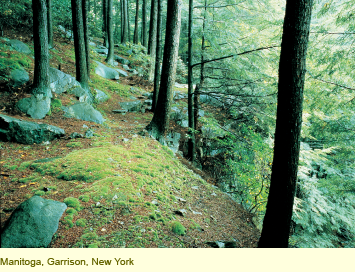Exhibitions
- May 14, 2011-February 15, 2012
Writing the Garden: Books from the Collections of The New York Society Library and Elizabeth Barlow Rogers - May 21-August 29, 2010
Romantic Gardens: Nature, Art, and Landscape Design Rare books from the collections of the Morgan Library and Museum and Elizabeth Barlow Rogers
Lectures and Symposia
- June 2, 2010
How Romantic is Now? Spotlight on Contemporary Landscape Design - May 26, 2010
Great Romantic Landscapes: Central Park and Frederic Church's Olana - January 15, 2008
How Green is My City? New York Today and in 2030 - January-April 2007
Nature and Place: A Series of Conversations with Elizabeth Barlow Rogers - January-April 2006
The American Landscape: Ideals, Influences, Innovations
Nature and Place: A Series of Conversations with Elizabeth Barlow Rogers
A lecture series co-sponsored by the New York Botanical Garden, the New-York Historical Society, and the Foundation for Landscape Studies
 Nature and human beings exist in a perpetual bond, the outcome of which is never predictable. The confidence in the technological mastery of nature prevalent in the first two-thirds of the last century is seriously questioned by many people today. Natural disasters defy the engineer with unexpected and often cataclysmic destruction. At the same time, nature still inspires a sense of wonder that calls us to its defense in the face of our own destructiveness. For landscape designers especially, nature is an indispensable partner. This series consisted of four talks on the nature of good place-making.
Nature and human beings exist in a perpetual bond, the outcome of which is never predictable. The confidence in the technological mastery of nature prevalent in the first two-thirds of the last century is seriously questioned by many people today. Natural disasters defy the engineer with unexpected and often cataclysmic destruction. At the same time, nature still inspires a sense of wonder that calls us to its defense in the face of our own destructiveness. For landscape designers especially, nature is an indispensable partner. This series consisted of four talks on the nature of good place-making.
Rick Darke
A Gardener's Conversations with the Woods
Tuesday, January 9, 2007
Rick Darke, a naturalist-turned-gardener, reflected upon three decades of
woodland observation in a series of photographs showing the transformation of particular landscapes through the seasons and over time. He discussed the influence these images have had on his design of gardens.
Tony Hiss
Two Addresses for New Yorkers to Call Home: The H2O Landscape
Tuesday, February 13, 2007
Tony Hiss presented the startling findings behind his most recent book, H2O: Highlands to Ocean, which show that despite four hundred years of nonstop growth in the New York City area, so much spectacular natural land and water survive that everyone here has two addresses: a street address and a place in the larger landscape.
Tim Davis
The American Parkway: Past, Present and Future
Tuesday, March 6, 2007
Parkways combine recreation, transportation, and natural resource protection in landscapes specifically designed to promote the enjoyment of scenery in motion. This conversation with Tim Davis traced the evolution of the American parkway and highlighted contemporary management concerns.
Carol Franklin
Nature in the City
Tuesday, April 10, 2007
Carol Franklin, a landscape architect, reflected on how existing and future park systems based on rivers and their tributaries protect regions, cities, and neighborhoods from the worst effects of urban sprawl: destruction of natural areas, a general loss of urban character, and homogenization of the suburban landscape.
